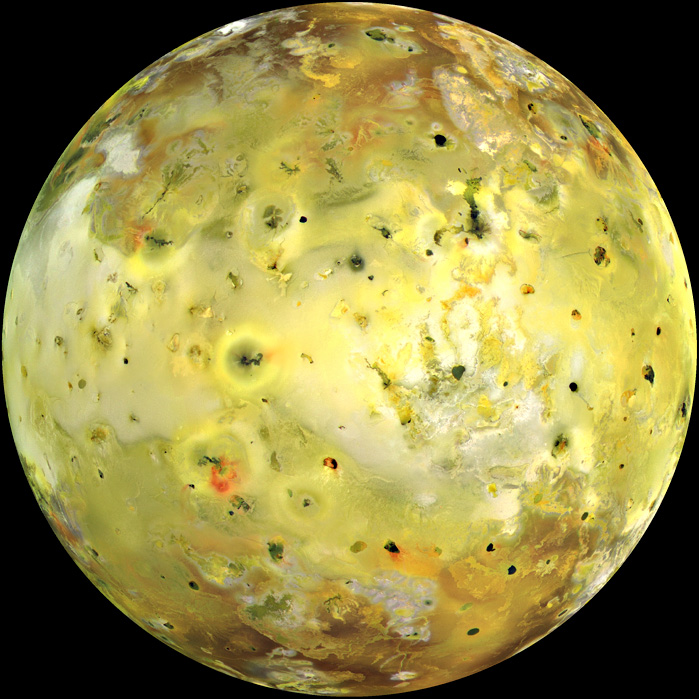
Caption: Io in approximately true color taken by the Galileo probe, 1999 Jul03.
Features:
- On the image, 3-kilometer features can be resolved.
- The blacks and reds mark volcanic features.
They are sulfur
compounds.
The white is solid sulfur dioxide (SO_2).
The green is ??? sulfur compounds too I suppose.
Molten sulfur lava is black and solidified sulfur lava is red or orangy or yellowy (HI-216).
- Io is the most geologically active body
in the Solar System with
the geology being driven by tidal flexing
due to Jupiter's
tidal force---it has
tidal-flexing-heating geology.
Because Io is a small body, the primordial heat of formation and past and present radioactive decay is completely insufficient to give Io active geology acting by itself and it makes only a minute contribution to the active geology Io has. So there is little primordial-radiogenic heat geology (see also Wikipedia: Earth's internal heat budget: Radiogenic heat: Primordial heat).
Of course, Io has long-lived radioactive isotopes (see, e.g., radiogenic_heat.html). But they produce heat energy so slowly that their heat energy would just leak out by heat conduction without causing volcanism if they acted alone in the absence tidal flexing.
- Because of its great geologically activity,
almost every image of Io
shows an erupting volcano---or so it seems.
Many large-scale features have altered even during the lifetime of the Galileo probe.
- Io has no (or almost no) significant
impact craters,
since its surface is continually being renewed.
It does have lots of volcanic craters, of course.
- The tidal flexing/heating occurs even
though Io's orbital and rotational
periods are synchronized so that Io always turns the same
side to Jupiter.
Gravitational perturbations from the other Jupiter moons keep Io's orbit from being perfectly circular. The tidal flexing/heating occurs as Io moves closer and farther from Jupiter.
- Io
is permanently stretched by several kilometers along the
Io-Jupiter line.
The tidal flexing causes the surface
of Io to rise and
fall in places by about 100 m.
- The interior of Io must be molten
sulfur,
silicates, and
metals (in ordinary meaning).
- The surface is cold away from the
erupting volcanoes: maybe 80 to 150 K.
The lava temperatures are typically 400 to 600 K, but some places may
be has hot as 2000 K
(HI-215).
- Io long ago has lost its volatiles
(e.g., hydrogen,
helium,
water, and
carbon dioxide (CO_2)).
They were evaporated by volcanic heat and then
underwent rapid atmospheric escape
(rapid on geological time scales)
because of Io's low
gravity, in particular, low
surface gravity.
- On Io,
the lavas
are sulfur,
sulfur compounds,
and, for the hottest volcanoes,
silicates.
The gas, which explosively evaporates from liquid to gas when the pressure of the lava falls as it rises to the surface, is sulfur dioxide. In terrestrial volcanoes, water fills this role.
The plumes of sulfur ash can rise up 100 km and some material escapes Io altogether.
- Additional references: FMW-234,
HI-215,
Se-508, and
Cox-303--307.
Download site: NASA: Color image of Jupiter's satellite Io.
Image link: Itself.
Local file: local link: jupiter_io_full.html.
File: Jupiter moons file: jupiter_io_full.html.